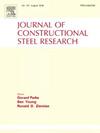Fatigue of rib-to-deck joints repaired by adhesively bonded patches: Tests and models
IF 4
2区 工程技术
Q1 CONSTRUCTION & BUILDING TECHNOLOGY
引用次数: 0
Abstract
Rib-to-deck joints in orthotropic steel decks of bridges are known to be prone to fatigue cracks. Repairing such cracks allows for prolonging the life of the infrastructure, provided that structural safety is guaranteed. The fatigue performance of rib-to-deck joints repaired by adhesively bonded patches is experimentally and numerically studied. Two repair schemes, one including bonding patches on the top of the deck and the other one involving bonding patches between the bottom of the deck and the U-rib, are considered. The patch material, patch size, and load levels are varied. The experiments show that specimens repaired with large patch sizes and high Young's modulus have a longer residual fatigue life than similar specimens with small patch sizes and low Young's modulus. Specimens subjected to low load levels demonstrate better bonding behavior during the test than similar specimens subjected to high load levels. The residual fatigue life of the rib-to-deck joints before and after repair are derived from the tests. A finite element analysis reveals that a thicker patch gives a greater reduction of stress but debonding becomes more likely at the edge of the patch. This study provides guidance to the design and application of adhesively bonded patches in repairing rib-to-deck joints in orthotropic steel decks.
求助全文
约1分钟内获得全文
求助全文
来源期刊

Journal of Constructional Steel Research
工程技术-工程:土木
CiteScore
7.90
自引率
19.50%
发文量
550
审稿时长
46 days
期刊介绍:
The Journal of Constructional Steel Research provides an international forum for the presentation and discussion of the latest developments in structural steel research and their applications. It is aimed not only at researchers but also at those likely to be most affected by research results, i.e. designers and fabricators. Original papers of a high standard dealing with all aspects of steel research including theoretical and experimental research on elements, assemblages, connection and material properties are considered for publication.
 求助内容:
求助内容: 应助结果提醒方式:
应助结果提醒方式:


